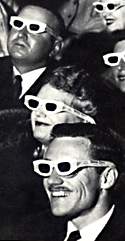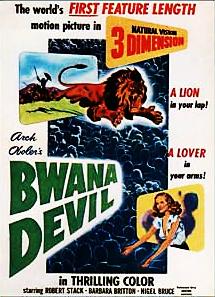 Movie studio executives worried that the new medium, television, would steal away their audiences. What was required was a hook to bring people back into the movie theatre. As the strippers sang in “Gypsy,” you gotta have a gimmick.
Movie studio executives worried that the new medium, television, would steal away their audiences. What was required was a hook to bring people back into the movie theatre. As the strippers sang in “Gypsy,” you gotta have a gimmick.
Even though 3-D movies had been around as far back as 1922 and had lost favor, it was decided to try again. Arch Oboler’s “Bwana Devil” started the 3-D craze of the Fifties. It premiered on Nov. 26, 1952 and starred Robert Stack, Barbara Britton and Nigel Bruce. (see poster below)
An African adventure film (A Lion in Your Lap, A Lady in Your Arms!) about man-eating lions which would jump off the screen at you, it made for pretty exciting watching when the process worked right. People were issued glasses which facilitated the 3-D effect.
Previously, 3-D used the anaglyphic process and those glasses were the red and green ones. This distorted the whole film by discoloration. Enter Polaroid and a newer system called Natural Vision.
Here’s how 3-D basically works. Each of your eyes sees a slightly different image which your brain combines into one. Unless that is artificially manipulated by say, 3-D glasses, in which case you brain processes the difference as depth or three dimensions.
 The Polaroid system depends upon delivering to the viewer’s eyes two separate images taken from a camera with twin side-by-side lenses. Now the glasses are actually Polaroid lenses. The color 3-D films made use of Polaroid separation, named after a process invented by Dr. Edwin Land, the camera guy. 3-D technology used two projectors showing the two camera views. The output of the projectors was run through a polarizing filter.
The Polaroid system depends upon delivering to the viewer’s eyes two separate images taken from a camera with twin side-by-side lenses. Now the glasses are actually Polaroid lenses. The color 3-D films made use of Polaroid separation, named after a process invented by Dr. Edwin Land, the camera guy. 3-D technology used two projectors showing the two camera views. The output of the projectors was run through a polarizing filter.
Polaroid glasses were nearly clear and so did not detract from the viewing expericence.
What was tricky about it was the projection. If it wasn’t done perfectly by the movie theatre, the whole thing just looked like a blurry mess. And then there were the headaches many people suffered watching 3-D movies. Owners of movie houses weren’t especially keen on exhibiting movies that made many of their customers run for the aspirin bottle.
At first industry experts predicted that 3-D would do for movies what the “talkies” had done. Some surprising titles were filmed in 3-D, such as Hondo, Kiss Me Kate and Dial M for Murder. But often their 2-D versions outsold the 3-D, and the industry got the big hint.
3-D comics fared a bit better and are still valued by collectors. But 3-D movies began a slide into low budget productions. Newer, more interesting technologies such as CinemaScope quickly eclipsed the 3-D movies. They only required one projector and saved on the aspirin costs!>
